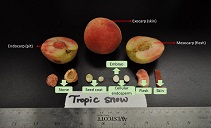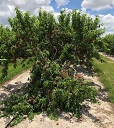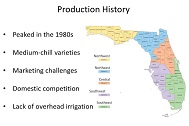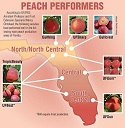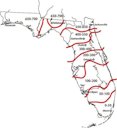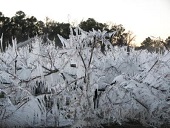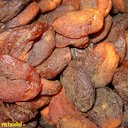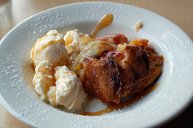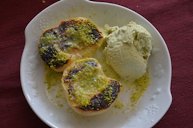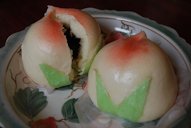| Peach - Prunus persica | |||||||||||||||||||||||||||||||||||
|---|---|---|---|---|---|---|---|---|---|---|---|---|---|---|---|---|---|---|---|---|---|---|---|---|---|---|---|---|---|---|---|---|---|---|---|
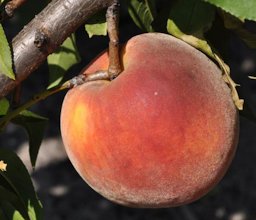 Fig. 1 Prunus persica 'Tropic Beauty' peach 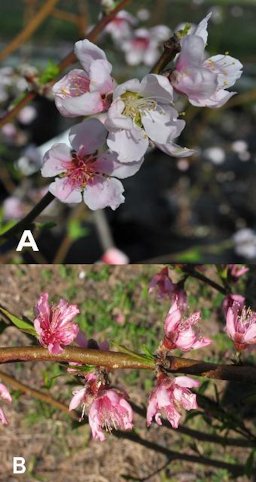 Fig. 2 Showy (a) and non-showy (b) peach flowers 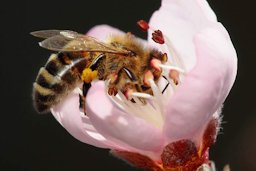 Fig. 3  Bee pollinating peach flower 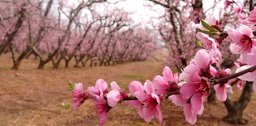 Fig. 4  Flowering peach branch between rows of trees 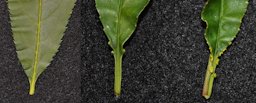 Fig. 8  Eglandular (a), globose (b) and reniform (c) leaf glands on peach leaves 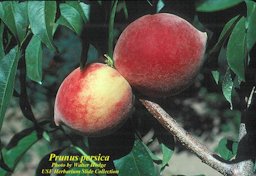 Fig. 9  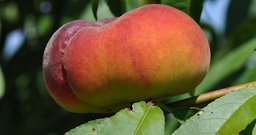 Fig. 10  Peach ‘UFO‘ 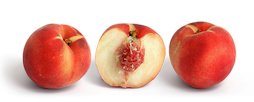 Fig. 11  White peach and its cross section 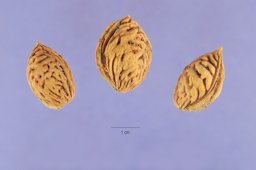 Fig. 12  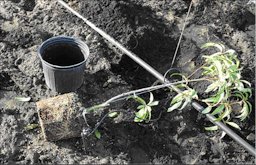 Fig. 13  Containerized peach tree in a 3-gallon container ready for planting. Remove some soil from roots to improve root contact with field soil. 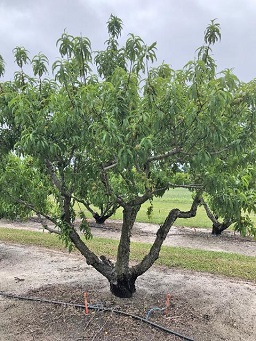 Fig. 14  Peach tree trained to an open center 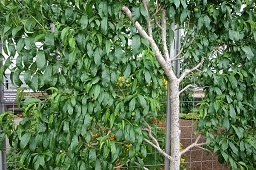 Fig. 15  Botanical specimen in Longwood Gardens, Pennsylvania, USA, (espaliered) 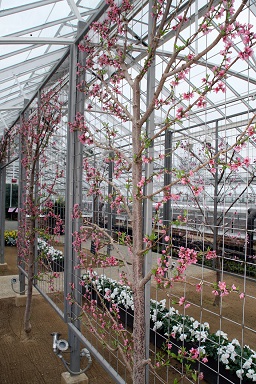 Fig. 16  P. persica var. nucipersica 'Lafayette' in Longwood Gardens, Pennsylvania, USA (espaliered) 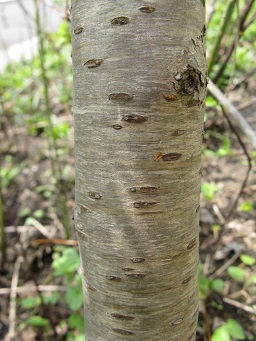 Fig. 20 P. persica, cultivated plant, Toronto, Canada 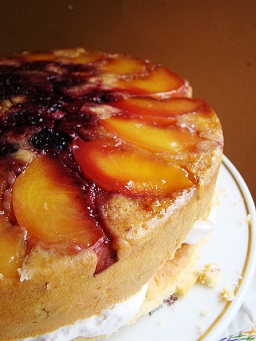 Fig. 33 Vegan upside down blackberry peach pecan cake with pecan kreme  Fig. 34  Florida peach season 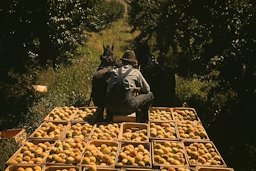 Fig. 35  Hauling crates of peaches from the orchard to the shipping shed |
Scientific
name Prunus persica (L.) Batsch Pronunciation PROO-nus PER-sick-uh Common name English: clingstone, freestone, peach; Finland: persikka; Chinese: hao ren, shou tao; French: pêcher, pêche; German: Pfirsich; Italian: persico, pesco; Japabese: momo; Korean: poksunganamu; Russian: персик обыкновенный [persik obyknovennyj]; Spanish: duraznero, persico; Turkish: şeftali; tho (Thailand) 19 Synonyms P. persica f compressa (Loudon) Rehder; P. persica var. nucipersica (Suckow) C.K. Schneid; P. persica f persica; P. persica var. persica 9 Relatives Apple, Malus domestica; blackberry, Rubus spp; capulin, P. salicifolia; chickasaw plum, P. angustifolia; loquat, Eriobotrya japonica; mayhaw, Crataegus spp.; pear, Pyrus spp. and strawberry, Fragaria ananassa 8 Family Rosaceae (rose family) Origin China USDA hardiness zones 5B- 8B Uses Fruit; highway median; bonsai; espalier 1 Height 15-25 ft (4.5-7.6 m) Spread 15-25 ft (4.5-7.6 m) Crown Round, dense, irregular Plant habit Semi-spreading or semi-upright; not showy; typically multi-trunked 1,2 Growth rate Fast Longevity Estimated life span of 10–15 years 18 Pruning requirement Needed for strong structure Leaves Deciduous; simple; alternate; serrate, serrulate; lanceolate, elleptic; 2-4 in. (5-10 cm), 4-8 in. (10-20 cm) 2 Flowers White/cream/gray, pink, red; showy; in the late winter 2 Fruit Round; 3-6 in. (7.6-15 cm); yellow, red; fleshy; melting or non-melting 2 Season Mar.-May 12 USDA Nutrient Content pdf Light requirement Full sun, partial sun or partial shade 2 Soil tolerances Clay; sand; loam; acidic; well-drained 2 pH preference 6.0-6.5 Drought tolerance Moderate Aerosol salt tolerance Unknown Soil salt tolerance Unknown Cold tolerance 27 °F (-2 °C) for fruit and flower; tree hardy Plant spacing 10-15 ft (3-4.5 m) between trees; 15-25 ft (4.5-7.6 m) between rows 18 Roots Not a problem Invasive potential * Little invasive potential Pest/disease resistance Sensitive to pests/diseases Verticillium wilt susceptibility Susceptible Known hazard The interior of the pit is poisonous; twigs and leaves are toxic 8 Reading Material Organic Peach Production in Florida, University of Florida pdf Florida Peach and Nectarine Varieties, University of Florida pdf Prunus persica: Peach, University of Florida pdf The University of Florida has developed high-quality, low-chilling, early-maturing peach and nectarine cultivars that can be grown from the panhandle of Florida to as far south as Immokalee. Low-chilling cultivars can grow and produce fruit under Florida conditions that are much warmer in winter than in northern states. Furthermore, ripening of these cultivars during April and May ensures an early spring market window for tree-ripe fresh fruit in Florida before peaches and nectarines from other southeastern states and California come to market. 1 Origin The peach (Prunus persica) is a deciduous tree native to the region of Northwest China between the Tarim Basin and the north slopes of the Kunlun Shan mountains, where it was first domesticated and cultivated. 4 The specific epithet persica refers to its widespread cultivation in Persia, whence it was transplanted to Europe. 5 Description Peach trees vary in their growth habit, and often a combination of tree vigor, flower type, and leaf structure can be used to identify cultivars. Trees can have semi-spreading (e.g., ‘UFOne’) or semi-upright growth (e.g., ‘Flordaprince’) and can be either very vigorous (e.g., ‘UFSun’) or moderately vigorous (e.g., ‘Sunbest’) in canopy growth. 3 Flowers Flowers on certain peach cultivars can be showy, with large, pink petals; flowers on other cultivars are non-showy, with smaller, redder petals (Fig. 2). Leaf glands at the base of the leaf near the petiole can also be used in the identification process. 3
Leaves Leaf glands may be absent (eglandular), or they may be globose (round) or reniform (kidney-shaped) (Fig. 7). 3 Fruit The total attractiveness of fruit is related to shape, size, color, and flesh browning. Fruit shape, firmness, taste, flesh browning, and overall attractiveness are also rated subjectively. Round to oblong fruit shape is desirable, and ratings are lowered by the degree of protruding tips and sutures. Fruit with the high aroma, moderate acidity, and sweet taste are the most desirable. A high degree of rapid browning from cuts and bruises on soft ripe fruit is not desirable. Most recent releases from the UF breeding program have little or no browning of the flesh. 1  Fig. 7  Fig. 7. Fruit growth stages in ‘UFSun’. The four stages of peach fruit development: flowering, cell division, pit hardening, and cell expansion. Harvesting The red “blush” on the peel is formed in response to sunlight exposure and is not related to maturity. Peach fruit begin to ripen at the tip or blossom end and firmness should be assessed as the ground color begins to change. 18 Melting vs Non-Melting Peaches are typically available in two different flesh types, melting and non-melting. Melting-flesh peaches undergo a rapid softening of the flesh as the fruit ripen. Historically, this type of fruit has been used for fresh fruit production. Non-melting-flesh peaches are characterized by a firm flesh phenotype that softens slowly. Non-melting-flesh peaches had primarily been used for processing; however, improvements in flavor and texture through breeding at the University of Florida and elsewhere have resulted in non-melting-flesh peaches with superior fruit characteristics for eating fresh. 1 Clingstone vs Freestone Clingstone and freestone are two terms that describe the relative tendency of the flesh to adhere to the pit. In a clingstone peach, the flesh adheres to the pit so that the pit cannot be easily extracted from the flesh when the fruit is sliced in half. All non-melting-flesh peach cultivars released by the University of Florida are clingstone or semi-clingstone (the flesh of semi-clingstone peaches becomes easier to separate from the pits as the fruit ripen). Peach fruit with flesh that separates easily from the pit are described as freestone. Typically, melting-flesh peach cultivars are semi-freestone or freestone; however it is possible to have a melting-flesh, clingstone peach. Although there is some variation in the degree of flesh adherence (e.g., semi-freestone or semi-clingstone), no non-melting-flesh, freestone peach cultivars are available. 1 Climatic Fruit Peaches are considered a climacteric fruit, which means that fruit is able to continue ripening after they are harvested, although the sugar level and therefore perceived sweetness will not increase. Often, peaches that consumers purchase may be firm, but they will soften and develop more aroma when placed on a counter or in a fruit bowl. Fruit that is allowed to ripen on the tree have better fruit quality by many standards of measurement, but particularly sweetness. Florida’s unique environment allows commercial growers to harvest “tree-ripe,” non-melting-flesh cultivars that are firm and possess very high-quality. 1 Cultivars for Central and South Florida Pollination All peaches are self-pollinating. Propagation Peaches and nectarines in Florida must be planted on a rootstock that is resistant to a specific root-knot nematode found only in Florida (Meloidogyne floridensis). 11 Currently, there are three commercially available rootstocks, 'Flordaguard' (a peach rootstock) and 'Sharpe' (a clonal plum rootstock) that are resistant to M. floridensis. 'MP-29' is a third rootstock that is being tested in two locations in Florida and is available for commercial propagation. 'Sharpe' rootstock is recommended for dooryard or backyard orchards, as there has been a slight decrease in fruit size associated with this rootstock. 'Flordaguard' trees are visually distinctive with young leaves exhibiting a deep red color. 11 Rootstocks for Florida Stone Fruit, University of Florida pdf Planting Trees can be transplanted at any time of the year. Transplants grown in pots are best planted after the last freeze in the spring, and bare-root transplants are best planted in the fall or winter. Trees should be placed in the ground, without stakes, such that the ground soil line is even or slightly above the media in the transplant pot or former soil line for bare-root trees. 18 Pruning During the first two to three years after planting, young trees are trained to develop a branching system or tree canopy that will later support a well distributed crop. Although each tree will grow differently with few trees being perfectly symmetrical, the overall goal for peaches and nectarines is to develop an open center or vase-shaped tree with a spreading but upright growth habit (Fig. 14). 3 In contrast to citrus, peach trees grown in Florida require two pruning events, one in the summer and one in the winter. Summer pruning occurs after harvest (postharvest pruning) in May and no later than June. 18 The ultimate aim of summer pruning is to allow light to penetrate inside the canopy. This will help the tree to develop good flower buds and will induce the growth of new fruiting wood close to scaffold branches for the next season. At summer pruning: • Remove suckers. • Perform manual or mechanical topping (~7 to 8 feet). • Eliminate some laterals if the growth is excessive. • Do not allow old fruiting wood in the body of the tree to develop into heavy branches. • Remove old fruit and dead shoots. The amount of pruning required in winter is greatly reduced and pruning cuts in winter take longer to heal than cuts made on actively growing shoots in the summer. This lowers the overall incidence of disease infiltrating pruning cuts. 16 Summer Pruning in Low-Chill Peaches Grown in Florida, University of Florida pdf Training and Pruning Florida Peaches, Nectarines and Plums, University of Florida pdf Pruning Peach Trees, Virginia Tech, Cooperative Extension pdf Simple Tree Training Technique for Peaches, University of Georgia pdf Thinning Peach trees absorb water and nutrients from the soil and utilize sunlight to convert CO2 to carbohydrates by photosynthesis. Fig. 17 shows the morphological structure of a peach fruit. All fruit on an individual tree must share these nutrients and carbohydrates; thus, excessive fruit load will cause several problems, including small size, poor flavor, excessive fruit load, delayed fruit maturation, and reduced plant vigor. 12 After the last chance of a freeze, but before the peach fruit begin to rapidly increase in size, flowers and fruitlets should be removed by hand or with machinery (also called thinning) to a density of one fruit for every 6–8 inches (15–20 cm). To promote maximum fruit size, fruitlets and flowers should be thinned when the fruitlets are no longer than 1 inch (25 mm) from stem to tip and their stones are still soft. However, thinning later, after the stones harden and the fruit are longer than 1 inch, will not increase final fruit size. 18
Fig. 17. Peach fruit anatomy Fig. 18. A good fruit size stage to do thinning Fig. 19. No thinning can result in overloaded and broken limbs Thinning Florida Peaches for Larger Fruit, University of Florida pdf Peach Pruning and Thinning Pointers, Vegetable and Specialty Crop News Fertilizing The type of fertilizer you choose may be chemical or organic. Make sure that the fertilizer contains iron, zinc, manganese, magnesium, molybdenum, copper and boron. These minor elements are very important to plants and most soils are low in these elements. 7 Irrigation Both bare-root and containerized trees should be watered at planting to reduce transplant shock. Newly planted trees should receive 2–3 gallons of water for every inch of trunk diameter. Bare-root trees are dormant at planting, have no leaves, and usually require little if any water at planting, except on very sandy soils. 1 Bearing trees must be irrigated to increase fruit size and yield and support tree growth. Suggested irrigation rates are 1–2 inches every 10 days and more frequently in sandy soils, especially during the dry season. 1 The most critical timing for peaches regarding crop water demand is between January and May (21–120 DOY). During this time, the growth stage is characterized by flowering, leaf expansion, fruit development, and fruit maturation. Maintenance of adequate soil moisture in the root zone is crucial for achieving yield potential and fruit quality, mainly because of the increasing crop water demand and lower seasonal precipitation rates. 17 Irrigation Practices for Peaches in Florida, University of Florida pdf Production The marketing season for US-grown peaches peaks from May 20 to September 30 (Fig. 22), while the target market window for Florida peaches is from the last week of March to the last week of May. Peaches are imported from Chile to the US from October to March. Peaches in Florida hit the market before Georgia, South Carolina, and California and have a target market window with little competition (March to May). 12 One of the main advantages of growing peaches in Florida is that growers can typically obtain higher prices for their fruit from March through early May. The reason behind the higher prices is that the state’s peach producers have the advantage of producing the first domestic peaches each calendar year. 10 In order to have marketable fruit diameter, the fruit must be at least 2¼ inches in diameter; although there is increasing pressure from grocery store produce buyers for this minimum to be 2½ inches. However, low-chill stone fruit has a short fruit developmental period, and this, coupled with its early ripening window tends to produce smaller fruit. New stone fruit varieties are being selected with one emphasis being large fruit size to account for this short fruit developmental period. Growers receive a premium for large diameter fruit early in the season (i. e., >2½ inch), thus proper thinning is essential for optimum yield and profit. Although there isn't one consistent spacing that works for all varieties, there is a general trend towards greater percentages of large fruit as the spacing between fruit increase. 13
Fig. 21. Production history Fig. 22. Annual volume of US peach imports, mainly from Chile, the main US peach marketing season, and the target market window for Florida-grown peaches. Fig. 23. UF stone fruit breeding program Florida Stone Fruit. A Taste of Summer in the Spring: Production and Challenges, University of Florida, Gainsville Extension pdf Bags Protect and Improve Peaches, Vegetable and Specialty Crop News Winter Defoliation for Florida Peaches, Vegetable and Specialty Crop News Alternative Opportunities for Small Farms: Peach and Nectarine Production Review, University of Florida pdf Establishment and Production Costs for Peach Orchards in Florida: Enterprise Budget and Profitability Analysis, University of Florida pdf Hydrogen Cyanamide for Low-Chill Peaches in Florida, Vegetable and Specialty Crop News Chill requirements In order to bloom in spring, deciduous fruit trees like peaches, plums, and nectarines all must go through the plant equivalent of a long winter's nap. They need a dormancy period with a certain number of chilling hours, when the temperature drops below 45 degrees Fahrenheit. The exact number of chilling hours depends on the fruit tree variety, but it can be anywhere from a hundred to more than a thousand. 14 The number of days from flowering to fruit set, or the fruit development period, is shorter for low-chill cultivars such as ‘Flordadawn’ that produces fruit in as little as 60 days after flowering. The most popular cultivars currently in production, ‘UFBest’, ‘TropicBeauty’, ‘UFSun’, and ‘UFOne’, have respective chill unit requirements of 100, 150, 100, and 150 hours and fruit respective development periods of 85, 89, 90, and 95 days. 18
Fig. 24. Historical chill unit accumulation, baded on hours below 45 °F received to Feb. 10th in 75% of winters Chill Accumulation in Peaches, University of Florida pdf Minimum Overnight Temperature, University of Florida ext. link Pest Page Disease Page Frost Protection Peach buds, flowers, and fruit can be damaged by late spring frosts. Peach flower buds that have just begun to swell can withstand temperatures to about 20 °F. Open blossoms show injury at about 26 °F. Following petal fall, the young fruit generally is killed by minimum temperatures of 28 °F. However, using overhead irrigation for freeze protection can prevent such damage. 15 The principle underlying the use of overhead irrigation for freeze protection is that heat lost from the trees is replaced by heat released as applied water turns to ice. As long as water is applied continuously at an adequate rate and is freezing, plant temperature will remain at or near 32 °F. 15 A properly irrigated orchard will coat the entire tree in ice (Fig. 26). Careful monitoring is necessary to ensure that a layer of ice continually forms. If the irrigation stops for any reason (e. g., blocked sprinkler, breaks in irrigation lines), damage can be more severe than if irrigation was not applied at all. Successive layers of ice can result in severe damage to the tree in the form of limb breakage and loss of scaffolds. In years with successive freeze events, retraining of these scaffold limbs will be necessary as shoots emerge through the growing season. 15
Fig. 26. Irrigation used for freeze protection in 2009 Frost Protection Irrigation for Florida Peaches: Economic Considerations, University of Florida pdf (archived) Food Uses
Fig. 27. The Peach Melba (French: pêche Melba) is a dessert of peaches and raspberry sauce with vanilla ice cream. The dish was invented in 1892 or 1893 by the French chef Auguste Escoffier at the Savoy Hotel, London, to honour the Australian soprano Nellie Melba. 6 Fig. 28. Dried unbleached peaches from Gothenburg, Sweden. Fig. 29. Peach cobbler with vanilla ice cream at City Hall Diner. Fig. 30. Pêche rôtie à la pistache accompagnée d'une boule de glace à la pistache (grilled peach with pistachio ice cream). Fig. 31. Soupe de pêche et rosé du Luberon (peach soup and rose wine from Luberon France). Fig. 32. Peach steamed bun, Narita-city, Japan. Dehydrated and Freeze-dried Peach Fruit: A Prolonged Shelf-life Product through Modern Drying Techniques, University of Florida pdf Small-Scale Juicing of Florida-Grown ‘UFSun’ Peaches, University of Florida pdf Florida Peaches: A Perfect Snack, University of Florida pdf Further Reading Home Garden Peaches, University of Georgia, Cooperative Extension pdf Peach, Plums and Nectarines, Just Fruits and Exotics nursery University of Florida Stone Fruit Breeding Program ext. link Operation Peaches in Florida ext link Florida Peaches, Florida Foundation Seed Producers ext. link Peach Botanical Art List of Growers and Vendors |
||||||||||||||||||||||||||||||||||
| Bibliography 1 Sarkhosh, Ali, et al.
"Florida Peach and Nectarine
Varieties." Horticultural
Sciences Dept., (originally
published in 1995 as "Peaches and Nectarines for Central and North
Florida), Circ. 1159, UF/IFAS Extension, Original
pub. Nov. 1995, Rev. May 2013, June 2016 and Oct.
2018, AskIFAS,
doi.org/10.32473/edis-mg374-2013, edis.ifas.ufl.edu/mg374.
Accessed 16 Feb. 2017, 2 Apr. 2019. Fig.
1 "Tropic
Beauty' peach." UF/IFAS
Extension, AskIFAS, edis.ifas.ufl.edu.
Accessed 18 Sept. 2014. ** Information provided is not intended to be used as a guide for treatment of medical conditions. Published Feb. 2013 LR. Last update 16 Sept. 2024 LR |
|||||||||||||||||||||||||||||||||||


